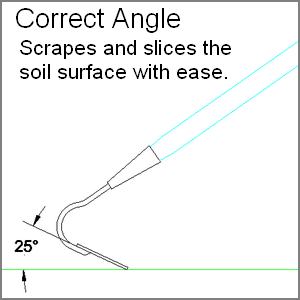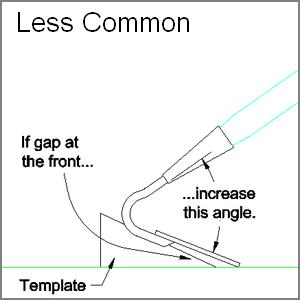How To Tighten A Garden Hoe
Can I adjust a garden hoe to fit my height?
Author: Greg Baka
Believe it or not, most garden hoes are adjustable. And getting the angles right will make the tool a joy to use, instead of an exhausting back-breaker.
Why should you adjust your hoe?
You should adjust your weeding hoe for two reasons:
- to protect your back and muscles
- to make weeding much faster and easier


If everybody was the same height, and all manufacturers made their tools with the proper blade angle, then this would not be necessary. But here in the real world, taking a few minutes to properly adjust your gardening hoe will lead to more enjoyable afternoons.
What is the proper blade angle for a weeding hoe?
It depends on they type of hoe it is. See our "Different types of garden hoes" article for more detailed info on the best blade angle for all 5 primary types of hoes. Only 2 of those types are adjustable...
The type most likely to need adjusting is called a "Draw Hoe", and it is the most common style of garden hoe. Other names for this type are Gooseneck, Pattern, Onion, Half Moon, Trapezoid, and American Standard Hoe. (see pictures farther below) These hoes should have 20 to 30 degrees between the blade and the ground. The printable template we provide for checking these hoes is made at 25 degrees to be in the middle of the range.
You may also need to adjust the type called a "Flat Hoe". Other names for these hoes are Push, Heart, Scuffle, Diamond, and Winged Hoe. Their blades need to lay flat on the ground while you hold the handle in a comfortable position. So you would bend their necks gently to achieve that parallel-to-the-ground alignment.
What type of garden hoes are adjustable?
Only those with a rod (called a neck) between the handle and the blade. The longer and thinner the neck, the easier the adjustment is.
Here are some examples of adjustable hoes:
What if I am tall or short?
The truly "average" person is hard to find. For hoeing, your leg length and arm length are more important that your height. The target distance to consider is your bellybutton height, because when standing in an ergonomic upright position that is where it is most comfortable to position the end of the hoe handle. Assuming that average bellybutton height is 38", the pictures below show how shorter or taller heights results in a big change in blade angle when sharing the same hoe. This is why adjusting YOUR OWN hoe is important.

What about just using a real long handle?
Switching to a longer handle is usually just a band-aid. Sometimes it helps, but it is not a cure-all. The handle does need to be fairly long to be comfortable. Five feet is a good typical length for a hoe. Four feet is probably too short. And six feet may be a little awkward for all but really tall folks to use. All the garden hoes from Easy Digging are 5 feet long.
How to make adjustments to a garden hoe:
To adjust a garden hoe, you just need a vise, and an angle template (a printable one is available here).
Step 1:
Print out the angle template. You can just cut out and use the paper one, or trace + cut it from thin cardboard for a more permanent template.
Step 2:
Stand with your hoe on a smooth floor. Hold it like you are weeding the garden. But do not hunch or bend over much, even if that is how you are used to hoeing. Stand fairly upright, with one hand on the end of the hoe handle at about bellybutton height, and the other hand about 1 foot in front. The hoe will not be straight out in front of your torso, it will be to your left or right, depending on your dominant hand. It helps to point your forward foot towards the hoe blade.
Step 3:
Have a friend get down on the floor and slide the template up close to the hoe blade. This will show how much adjustment is needed, and which direction.


Step 4:
Clamp the blade in a bench vise as shown*. If the vice has a vertical V-notch for round rods, try to position the neck in that notch.
To bend the hoe neck, push down (or pull up) on the ferrule (steel cone).
Do NOT push or pull on the wooden handle – it will damage the handle. Bend just a little at time, not all at once.

Step 5:
Start again at Step 2 to see how much additional adjustment is needed.
*If you do not have a vise, or do not have enough arm strength to bend the neck, we suggest taking the hoe and the template to your local welding shop. They will have a vice or hydraulic press strong enough to bend the neck.
Congratulations! You have done something that few gardeners ever do.
Now sharpen your garden hoe, and you'll be amazed how much more comfortable, easier, and faster your ergonomically-adjusted hoe is.
How To Tighten A Garden Hoe
Source: https://www.easydigging.com/garden-hoes/articles/adjust-hoe-angle.html
Posted by: madisonwidefirearm.blogspot.com

0 Response to "How To Tighten A Garden Hoe"
Post a Comment